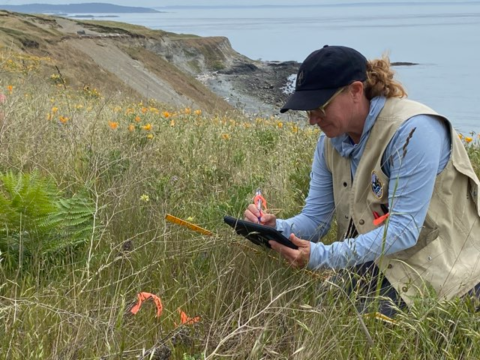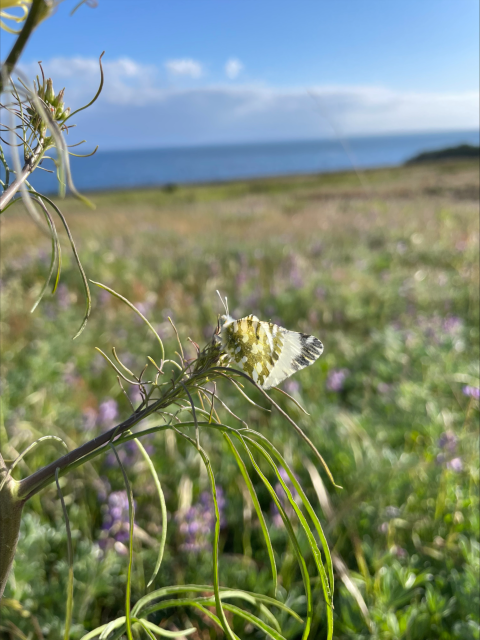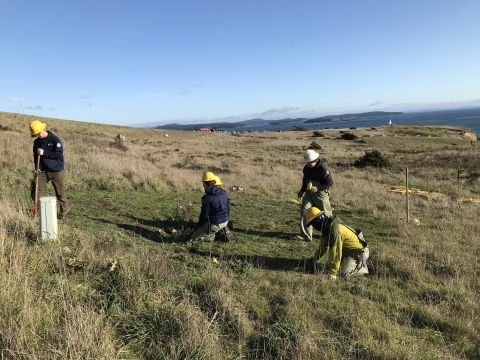Pollinators across Washington and California will benefit from nearly 400 acres of restored habitat thanks to dedicated conservation partners funded by the State Wildlife Grant (SWG) Program. Prairies, grasslands, and oak savannah habitat extend through British Columbia, Washington and Oregon, and into western California and Baja Mexico. This patchwork of habitats, home to many pollinator species, has experienced severe declines in recent decades due to development, invasive species invasive species
An invasive species is any plant or animal that has spread or been introduced into a new area where they are, or could, cause harm to the environment, economy, or human, animal, or plant health. Their unwelcome presence can destroy ecosystems and cost millions of dollars.
Learn more about invasive species , and climate change climate change
Climate change includes both global warming driven by human-induced emissions of greenhouse gases and the resulting large-scale shifts in weather patterns. Though there have been previous periods of climatic change, since the mid-20th century humans have had an unprecedented impact on Earth's climate system and caused change on a global scale.
Learn more about climate change impacts. While this project funds restoration work across 9 sites in Washington and California, prairie dependent species along much of the West Coast will benefit including several federally endangered butterflies like the Taylor’s checkerspot butterfly and island marble butterfly.
In California, only 1 percent of the original 9 million hectares of native prairie grasslands remain while in western Washington, historical grasslands have been reduced by approximately 91 percent. “These declining prairies are home to many at risk and protected species including grassland birds and federally endangered butterfly species like the Taylor’s and Quino checkerspots, island marble butterfly, Hermes copper butterfly, and the laguna mountain skipper,” said Dr. Julie K. Combs, Pollinator Species Lead for the Washington Department of Fish & Wildlife. “Through this restoration work our partners will improve the habitat and status of 22 Species of Greatest Conservation Need and provide secondary benefits to a dozen additional species that are highly associated with prairie, grassland, and oak habitats of western Washington and California.”
Proactive Actions and Partners
The SWG Program, administered by the Wildlife and Sport Fish Restoration Program (WSFR), provides funding for state fish and wildlife agencies to take proactive measures to assess the health of each state’s wildlife and their habitats, identify key threats, and outline the actions needed to conserve fish and wildlife. “Each state identifies species that are of greatest conservation need in their area and the steps needed to conserve these species and their habitats often before they become imperiled or at risk of extinction,” said Lia McLaughlin Biologist and Grants Management Specialist for WSFR. “This project supports proactive short and long-term goals for prairie dependent species and supports restoration on nearly 400 acres.” Prairie restoration efforts across the 9 sites include using prescribed fire and weed control, seeding areas with native plants, and building deer-exclusion fences to protect restored vegetation. Along with physical restoration the project also includes efforts to monitor the butterfly and bird species found in restored habitat.
“Partnership is key to the success of this large effort with many organizations coming together with a common goal to restore these habitats and the wildlife found there,” said Elspeth Kim, Director of Partnerships at Ecostudies Institute. “We have state agencies from Washington and California, land trust and land management organizations, academia, the Xerces Society, and our organization all working together to restore, monitor, and benefit species within these important prairie habitats.” Each partner plays a unique role and brings a specific set of skills to the restoration. Kim and her colleagues at Ecostudies Institute will contribute in a variety of ways including reintroductions of bird and butterfly species to recently restored habitat areas and coordinating species monitoring including conducting gap surveys for butterfly species in Oregon and northern Baja, Mexico.
Filling Information Gaps Across State and International Borders
Although Oregon and Mexico are not formal partners of the SWG supported project, information gathered from these areas will benefit two butterfly species supported by the funding. These coordinated actions in Oregon and Mexico are key for advancing information and recovery for the mardon skipper and the Quino checkerspot butterfly, a related subspecies of the Taylor’s checkerspot. Data gained from these areas will provide information about the species populations across their range and allow states and countries to share data and resources to aid rare and imperiled pollinator species. “Knowing where these pollinators are found, what habitat type they are utilizing, and what their population numbers are can help partners make informed decisions about species conservation at a large scale,” explains Combs.
Along with taking a holistic view of species range across hundreds of miles, these restoration partners are also working to restore habitat for a butterfly species whose entire current range covers only a few miles of prairies and dunes on the San Juan and Lopez Islands of Washington.
Island Marble Butterfly Recovery Efforts
Thought to be extinct since 1908, the island marble butterfly was re-discovered by biologists during a prairie survey in San Juan Island National Historical Park in 1998. Since then, the medium-sized creamy white butterfly has only inhabited a few small patches of prairie at American Camp and surrounding areas near the southern end of San Juan Island.
“The Department of Natural Resources Natural Areas Program manages the Cattle Point Natural Resources Conservation Area in part to protect native ecosystems and rare species, including the island marble butterfly,” said Dave Wilderman, Natural Areas Program Ecologist at Washington’s Department of Natural Resources. Cattle Point is one of the 9 supported restoration sites and is one of the only places the island marble butterfly exists. “Through this restoration effort we are continuing our work to control invasive plants and restore the area’s coastal bluff prairie and stabilized sand dunes.” Wilderman and his team work with the Salish Seed Nursery and the Center for Natural Lands Management Native Plant Nursery to source native and host plants for the endangered butterfly creating 15 ft x 15 ft patches of host plants for the insect to lay it’s eggs. Around the host plant patches, the team restores native wildflowers like chickweed and fiddleneck as a nectar source for the adult butterfly. “In a way we work with and create microhabitats, the host plant patches provide a place for eggs to hatch and larva to grow, the wildflowers provide a food source, we even use areas with more solar radiation on the hillside to provide the butterfly with the sunlight needed to warm their bodies to enable flight.”
The patch work of microhabitat supported by this restoration effort and the partnership can help increase the available area for the endangered butterfly to expand and lay the next generation. “Having the right habitat for the butterfly to grow, overwinter, and feed is essential to the species survival and recovery,” adds Wilderman.
Looking Forward
Looking forward the partners will continue their collaborative work to restore prairie habitat and aid native pollinators and at-risk prairie dependent species. Continued monitoring for all 9 restoration sites will also provide a consistent and repeatable framework for monitoring these populations and habitat conditions as prairie acres decrease and changing climate continues to present challenges for wildlife. “With so little prairie and suitable habitat remaining in Washington and California these sites aim to create ecological conditions that will stabilize or increase species populations,” added Combs. “In addition to supporting pollinators in general, our ultimate long-term goal of this project is the ability of state and federal agencies to keep numerous species off of endangered species lists and to recover those already listed.”
Learn more about the restoration of native wildflowers and grasses on the San Juan Islands https://sjclandbank.org/the-salish-seeds-project-bringing-back-island-w… and efforts to recover the island marble butterfly https://wdfw.wa.gov/species-habitats/species/euchloe-ausonides-insulanus







